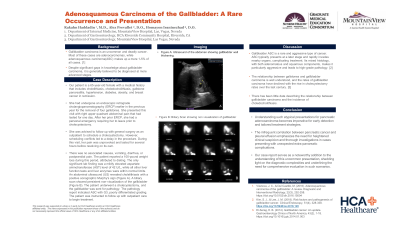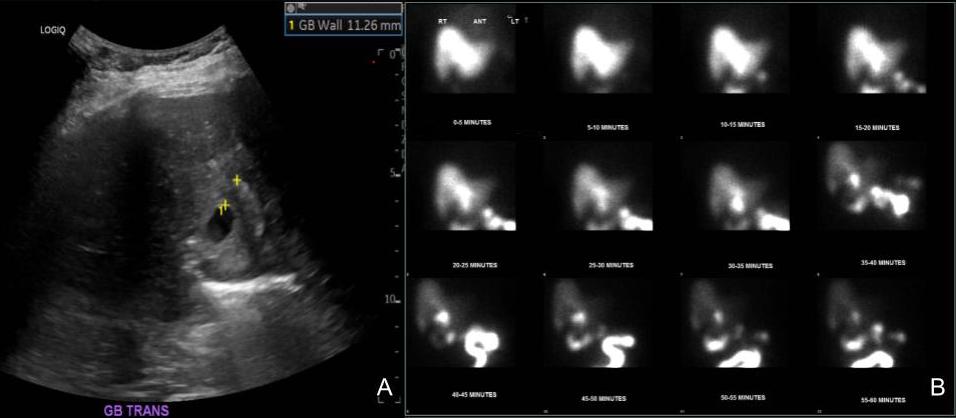Sunday Poster Session
Category: Biliary/Pancreas
P0147 - Adenosquamous Carcinoma of the Gallbladder: A Rare Occurrence and Presentation
Sunday, October 27, 2024
3:30 PM - 7:00 PM ET
Location: Exhibit Hall E

Has Audio

Rakahn Haddadin, MD
MountainView Hospital
Las Vegas, NV
Presenting Author(s)
Rakahn Haddadin, MD1, Alex Prevallet, DO2, Homayon Iraninezhad, DO1
1MountainView Hospital, Las Vegas, NV; 2HCA Riverside Community Hospital, Riverside, CA
Introduction: Gallbladder carcinoma is an uncommon and deadly cancer. Most of these cases are adenocarcinomas, while adenosquamous carcinoma(ASC) makes up a mere 1-5% of all cases. Despite significant gaps in knowledge about gallbladder carcinoma, it is generally believed to be diagnosed at more advanced stages.
Case Description/Methods: Our patient is a 65-year-old female with a medical history that includes cholelithiasis, choledocholithiasis, gallstone pancreatitis, hypertension, diabetes, obesity, and breast cancer in remission. She had undergone an endoscopic retrograde cholangiopancreatography (ERCP) earlier in the previous year for the removal of four gallstones. She presented this visit with right upper quadrant abdominal pain that had lasted for one day.
After her prior ERCP, she had a personal emergency requiring her to leave prior to cholecystectomy. She was advised to follow up with general surgery as an outpatient to schedule a cholecystectomy. However, scheduling conflicts led to a delay in the procedure.
During this visit, her pain was unprovoked and lasted for several hours before resolving on its own. There was no associated nausea, vomiting, diarrhea, or postprandial pain. The patient reported a 100-pound weight loss during this period, attributed to dieting.
The only significant lab finding was a mildly elevated aspartate aminotransferase (AST) level of 42 U/L, while all other liver function tests and liver enzymes were within normal limits. An abdominal ultrasound (US) revealed cholelithiasis with a positive sonographic Murphy's sign (Figure A). A biliary scan showed persistent non-visualization of the gallbladder (Figure B).
The patient underwent a cholecystectomy, and the gallbladder was sent for pathology. The pathology report indicated ASC with G3, poorly differentiated grading. The patient was instructed to follow up with outpatient care to begin treatment.
Discussion: Gallbladder ASC is a rare and aggressive type of cancer. ASC typically presents at a later stage and rapidly invades nearby organs, complicating treatment. Its mixed histology, with both adenomatous and squamous components, makes it particularly aggressive and leads to high-grade pathology. The relationship between gallstones and gallbladder carcinoma is well understood, and the rates of gallbladder carcinoma have declined with the rise in cholecystectomy rates over the last century. . There has been little data describing the relationship between gallbladder carcinoma and the incidence of choledocholithiasis.

Disclosures:
Rakahn Haddadin, MD1, Alex Prevallet, DO2, Homayon Iraninezhad, DO1. P0147 - Adenosquamous Carcinoma of the Gallbladder: A Rare Occurrence and Presentation, ACG 2024 Annual Scientific Meeting Abstracts. Philadelphia, PA: American College of Gastroenterology.
1MountainView Hospital, Las Vegas, NV; 2HCA Riverside Community Hospital, Riverside, CA
Introduction: Gallbladder carcinoma is an uncommon and deadly cancer. Most of these cases are adenocarcinomas, while adenosquamous carcinoma(ASC) makes up a mere 1-5% of all cases. Despite significant gaps in knowledge about gallbladder carcinoma, it is generally believed to be diagnosed at more advanced stages.
Case Description/Methods: Our patient is a 65-year-old female with a medical history that includes cholelithiasis, choledocholithiasis, gallstone pancreatitis, hypertension, diabetes, obesity, and breast cancer in remission. She had undergone an endoscopic retrograde cholangiopancreatography (ERCP) earlier in the previous year for the removal of four gallstones. She presented this visit with right upper quadrant abdominal pain that had lasted for one day.
After her prior ERCP, she had a personal emergency requiring her to leave prior to cholecystectomy. She was advised to follow up with general surgery as an outpatient to schedule a cholecystectomy. However, scheduling conflicts led to a delay in the procedure.
During this visit, her pain was unprovoked and lasted for several hours before resolving on its own. There was no associated nausea, vomiting, diarrhea, or postprandial pain. The patient reported a 100-pound weight loss during this period, attributed to dieting.
The only significant lab finding was a mildly elevated aspartate aminotransferase (AST) level of 42 U/L, while all other liver function tests and liver enzymes were within normal limits. An abdominal ultrasound (US) revealed cholelithiasis with a positive sonographic Murphy's sign (Figure A). A biliary scan showed persistent non-visualization of the gallbladder (Figure B).
The patient underwent a cholecystectomy, and the gallbladder was sent for pathology. The pathology report indicated ASC with G3, poorly differentiated grading. The patient was instructed to follow up with outpatient care to begin treatment.
Discussion: Gallbladder ASC is a rare and aggressive type of cancer. ASC typically presents at a later stage and rapidly invades nearby organs, complicating treatment. Its mixed histology, with both adenomatous and squamous components, makes it particularly aggressive and leads to high-grade pathology. The relationship between gallstones and gallbladder carcinoma is well understood, and the rates of gallbladder carcinoma have declined with the rise in cholecystectomy rates over the last century. . There has been little data describing the relationship between gallbladder carcinoma and the incidence of choledocholithiasis.

Figure: Figure A: Ultrasound of the abdomen showing gallbladder wall thickening.
Figure B: Biliary Scan showing non visualization of gallbladder.
Figure B: Biliary Scan showing non visualization of gallbladder.
Disclosures:
Rakahn Haddadin indicated no relevant financial relationships.
Alex Prevallet indicated no relevant financial relationships.
Homayon Iraninezhad indicated no relevant financial relationships.
Rakahn Haddadin, MD1, Alex Prevallet, DO2, Homayon Iraninezhad, DO1. P0147 - Adenosquamous Carcinoma of the Gallbladder: A Rare Occurrence and Presentation, ACG 2024 Annual Scientific Meeting Abstracts. Philadelphia, PA: American College of Gastroenterology.
